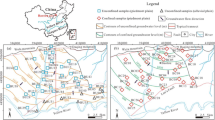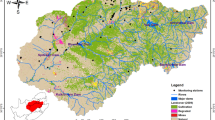Abstract
Understanding groundwater flow and chemistry is crucial to operate underground storage caverns because the groundwater flow and chemistry is mainly affected by the cavern operating conditions. Both classical (for example, graphical Durov diagram) and multivariate statistical methods [principal component analysis, (PCA) and cluster analysis, (CA)] were used to trace an effect of the injection of a sodium hypochlorite (NaOCl) disinfectant solution into the water curtain on the chemical compositions of groundwater and to calculate groundwater mixing ratio around liquefied petroleum gas underground storage caverns. Based on both hydrochemical analysis and statistical analysis, the groundwater samples in the study area were divided into four groups. Both CA and an end member mixing (EMM) calculation using the PCA results indicate that the chemical compositions of seepage water have been mostly influenced by waters from the water curtains. The propane seepage water is most influenced by the monitoring wells in the water curtain, with the largest mixing portion (34.2%), which indicates that a good performance of the water curtains in the propane area. The EMM model from the PCA results is used to calculate the mixing ratio and to identify the chemical evolution of groundwater evolution, providing clues to the groundwater flow and transport system around the underground storage caverns.







Similar content being viewed by others
References
Christophersen N, Hooper RP (1992) Multivariate analysis of stream water chemical data: the use of principal components analysis for the end-member mixing problem. Water Resour Res 28:99–107
De Windt L, Pellegrini D, van der Lee J (2004) Coupled modeling of cement/claystone interactions and radionuclide migration. J Contam Hydrol 68:165–182
Douglas M, Clark ID, Rave K, Bottomley D (2000) Groundwater mixing dynamics at a Canadian Shield mine. J Hydrol 235:88–103
Fitzpatrick ML, Long DT, Pijanowski BC (2007) Exploring the effects of urban and agricultural land use on surface water chemistry, across a regional watershed using multivariate statistics. Appl Geochem 22:1825–1840
Geostock (1985) Yukong LPG storage project in Ulsan final reconnaissance report. Yukong Gas Limited, Seoul
Geostock (1992) Ulsan LPG storage caverns Yukong gas hydrogeological monitoring. Yukong Gas Limited, Seoul
Gotkowitz M, Ellickson K, Clary A, Bowman G, Standridge J, Sonzogni W (2008) Effect of well disinfection on arsenic in ground water. Ground Water Monit Remediat 28:60–67
Hooper RP, Christopherse N, Peters J (1990) Modeling stream water chemistry as a mixture of soil water end member: an application to the Panola Mountain catchment, Georgia, USA. J Hydrol 116:321–344
Kim T, Lee KK, Ko KS, Chang HW (2000) Groundwater flow system inferred from hydraulic stresses and heads at an underground LPG storage cavern site. J Hydrol 236:165–184
Ko KS, Chang HW, Kim T, Lee KK (2002) Factors affecting the groundwater system around an underground LPG storage cavern. Q J Eng Geol Hydrogeol 35:279–290
Laaksoharju M, Skårman C, Skårman E (1999) Multivariate mixing and mass balance (M3) calculations, a new tool for decoding hydrogeochemical information. Appl Geochem 14:861–871
Lee J, Kim RH, Chang HW (2003) Interaction between groundwater quality and hydraulic head in an area around an underground LPG storage cavern, Korea. Environ Geol 43:910–912
Lee J, Kim JH, Kim HM, Chang HW (2007) Statistical approach to determine the salinized groundwater flow path and hydrogeochemical features around the underground LPG cavern, Korea. Hydrol Process 21:3615–3626
Lee J, Ko KS, Kim JM, Chang HW (2008) Multivariate statistical analysis of underground gas storage caverns on groundwater chemistry in Korea. Hydrol Process 22:3410–3417
Lindblom U (1989) The performance of water curtains surrounding rock caverns used for gas storage. Int J Rock Mech Min Sci Geomech Abstr 26:85–97
Mgelin RR (1991) Examining large database: a chemometric approach using principal component analysis. J Chemom 5:163–179
Mumford KG, MacGregor JF, Dickson SE, Frappa RH (2008) Multivariate analysis of ground water and soil data from a waste disposal site. Ground Water Monit Remediat 27:92–102
Park YD, Yoon HD (1968) Geologic map of Korea (Bangeojin sheet 1:50, 000). Geological Survey of Korea, Seoul
Rueedi J, Purtschert R, Beyerle U, Alberich C, Kipfer R (2005) Estimating groundwater mixing ratios and their uncertainties using a statistical multi parameter approach. J Hydrol 305:1–14
Stetzenbach KJ, Farnham IM, Hodge VF, Johannesson KH (1999) Using multivariate statistical analysis of groundwater major cation and trace element concentrations to evaluate groundwater flow in a regional aquifer. Hydrol Process 13:2655–2673
Stumm W, Morgan JJ (1996) Aquatic chemistry, 3rd edn. Wiley, New York
Suk H, Lee KK (1999) Characterization of a groundwater hydrochemical system through multivariate statistical analysis: clustering into groundwater zones. Ground Water 37:358–366
Thyne G, Gler C, Poeter E (2004) Sequential analysis of hydrochemical data for watershed characterization. Ground Water 42:711–723
Ward JH (1963) Hierarchical grouping to optimize an objective function. J Am Stat Assoc 58:236–244
Acknowledgments
This research was supported by the Basic Research Project (10-3414) of the Korea Institute of Geoscience and Mineral Resources (KIGAM) funded by the Ministry of Knowledge and Economy.
Author information
Authors and Affiliations
Corresponding author
Rights and permissions
About this article
Cite this article
Ko, KS., Lee, J., Lee, KK. et al. Multivariate statistical analysis for groundwater mixing ratios around underground storage caverns in Korea. Carbonates Evaporites 25, 35–42 (2010). https://doi.org/10.1007/s13146-009-0004-7
Accepted:
Published:
Issue Date:
DOI: https://doi.org/10.1007/s13146-009-0004-7




